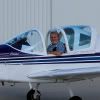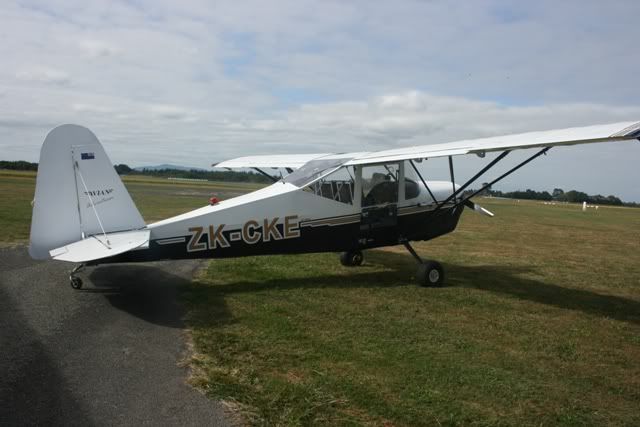|
|
Post by Peter Lewis on Aug 18, 2007 14:03:39 GMT 12
There have been a number of posts in other threads referring to the Bennett/Waitomo Airtruck, so I have dug out some photos of these and we can start a new thread. If anyone can add to or correct any details here, feel free to do so. The Bennett Airtruck was designed as a Tiger Moth replacement foragricultural work. The proposal matured around the same time as other such projects - the Fu24, Agricola, Andrews A.1 and EP9. The designer was Luigi Pellarini, who came up with pilot position above the engine/hopper module and the twin-boom concept as part of the design brief to make the aircraft safe in a crash and easy to load. Given the shortage of imported raw materials and engines, the prototype was assembled at Te Kuiti airfield mainly from surplus Harvard components by Bennett Aviation with operational input from Northern Air Services (an agricultural operator based at the field at that time). "It featured all aluminium structure, a high wing monoplane with a steel stub wing and V lift struts, steerable tricycle undercarriage, an extremely stubby pod fuselage, the cockpit (made from shortened Harvard glazing) being mounted directly over the radial engine, providing excellent forward view and very high drag, beneath it was room for a superphosphate hopper or up to 5 people in a cabin." The prototype was registered ZK-BPV (c/n BA-001), and the first flight was made at Te Kuiti on 28Apr60 (some sources quote a first flight in August 1960). The aircraft was at that time registered to Bennett Aviation, but soon after the company was restructured and became Waitomo Aircraft Ltd. After initial tests, BPV was hired to Northern Aviation for operational experience, and crashed at Ngapaenga 8Oct63. The pilot John Worthington survived, apparently owing his life to the built-in safety features of this aircraft. Scan originally posted in another thread by Dave, showing the derelict Harvards at Te Kuiti, and both Airtrucks:  and ZK-BPV after completion: 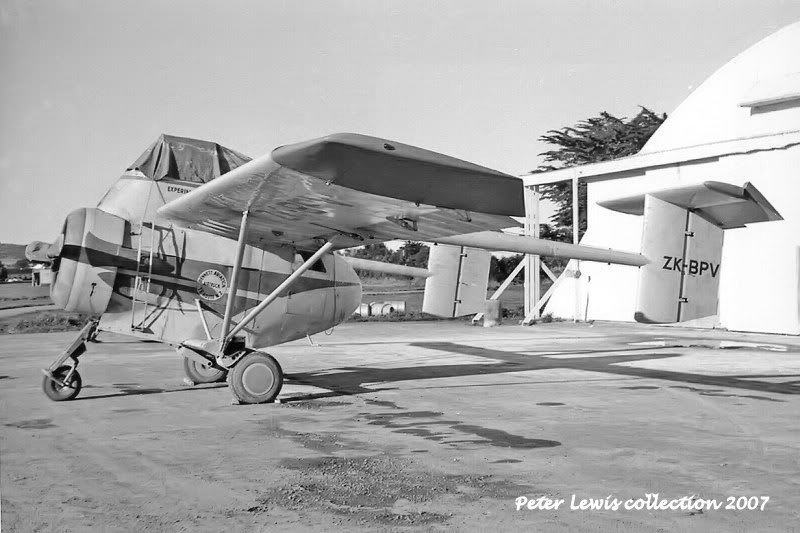 Given the operational success of this first aircraft, the company proceeded with the construction of a second machine, and this one first flew at Te Kuiti on 9 March 1965 as ZK-CKE (c/n 002) registered to Waitomo Aviation. The registered ownership soon after changed to Northern Air Services for the trial flights, and they may have used the aircraft operationally. In late February 1967, Barr Brothers Ltd. of Auckland hired the Airtruck, and used it operationally out of their Dargaville base. It did not last long, as it crashed in a failed t/off Tangiwha, Maungakaramea, 1Mar67. Pilot Dick Tatham was killed in the event. It was the end of the New Zealand based project. Pellerini had emigrated to Australia, and redesigned the concept as the PL-12 Airtruk (the name Airtruck was still the intellectual property of the New Zealand project) and that machine went into production there by Transavia. ZK-CKE attended an airshow held at Ardmore on the 28th January 1966, and the following photographs were taken at that time. The aircraft was painted white with red trim and the word AIRTRUCK in black: 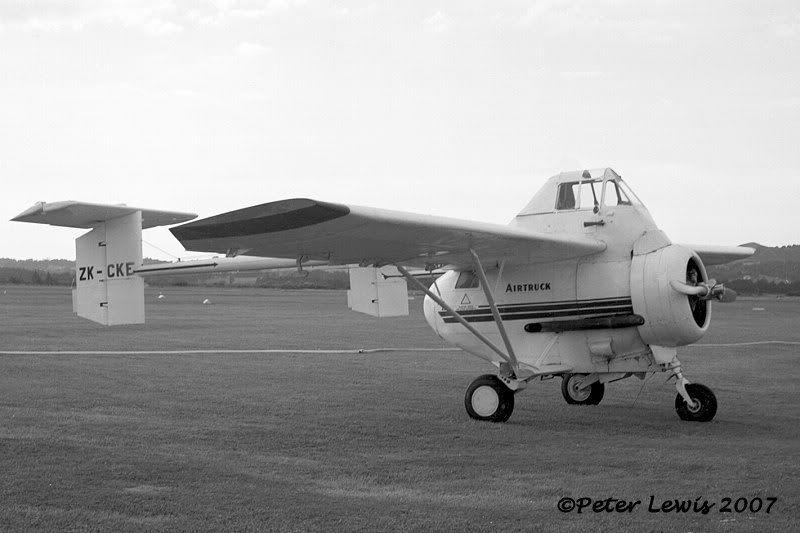 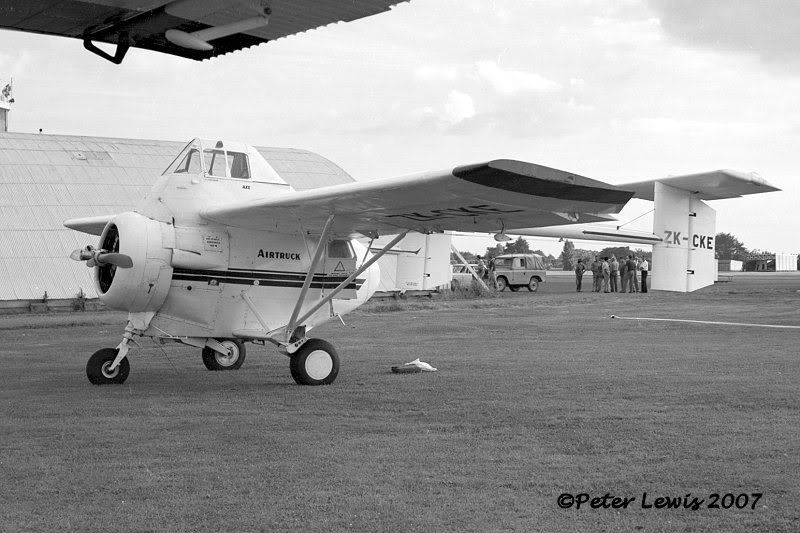  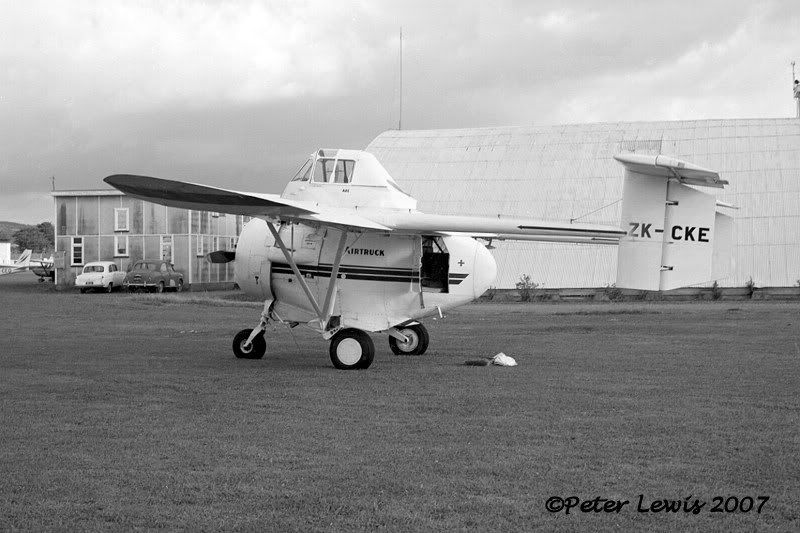 and yes the thing could actually fly: 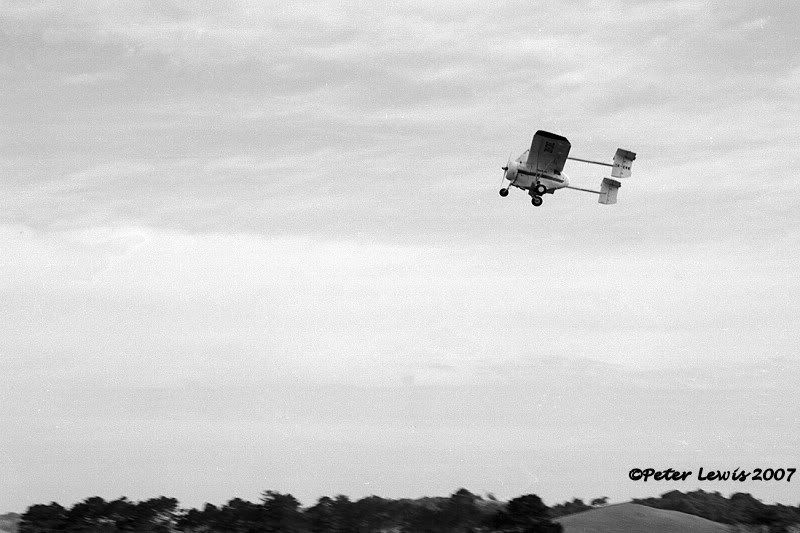 Colin has posted a colour photo of CKE at A.net www.airliners.net/open.file/0277578/L/and another one showing CKE working on a farm strip from Doug Sklenars. The pilot on this occasion is noted as Don Erceg, so this would have been prior to its Barr Brothers days: www.kiwibeavers.com/images/PL-11_Airtruck_CKE.JPGAgain, anyone who can add to this information here is most welcome. |
|
|
|
Post by Dave Homewood on Aug 18, 2007 15:21:13 GMT 12
Interesting stuff Peter. I guess this would be NZ's first commercially produced aircraft design then?
Was Luigi Pellarini a New Zealander or was he an Italian who moved here? Did he design anything else other than the Airtruck and Airtruk?
How does the boom arrangement improve safety in a crash? I can't work that one out.
I do not think I have ever seen a photo of one in flight before so that was interesting.
Also, you mention the 1966 airshow at Ardmore - perhaps more appropriate for another thread but I'd be keen to hear what sort of aircraft attended and what the flying displays were like. Do you have other photos and memories of this show, or others around that time please?
|
|
|
|
Post by Bruce on Aug 18, 2007 17:04:35 GMT 12
The twin booms were more for ease of loading than for safety. the key safety aspect was positioning the cockpit above the hopper and engine, on aircraft such as the Fletcher, the cockpits sits between these two heavy components, and sometimes becomes a crumple zone in frontal crashes. The drawback with the Airtruck (and Airtruk) was the possibility of the whole lot rolling forward end over end. Despite being hideously ugly, there was some merit in the design, which was actually ideal for the job it did. Unfortunately the PL12 did not have the same scope for development that the Fletcher did. The Hopper on the PL12 was an integral structural part of the fuselage, and couldnt be enlarged as engine power increased in the same way the Fletcher could. I have spoken to a number of PL12 pilots who all say that the Airtruk was a great machine to go to work in, and flew really well.
The PL11s do have a distinctive "Bitsa" look to them that the later PL12s didnt.......
Kinda cool in that quirky, ugly sort of way!
|
|
|
|
Post by 30sqnatc on Aug 18, 2007 23:27:45 GMT 12
Thanks for posting the pictures. I ocassionally look at an unassembled 1:48th Harvard kit I have in the garage and think mayby!!!
|
|
|
|
Post by 30sqnatc on Aug 18, 2007 23:50:25 GMT 12
|
|
|
|
Post by Peter Lewis on Aug 21, 2007 22:08:54 GMT 12
Luigi Pellarini was Italian, and apparently started his design career there. The earliest publicised project I can track is the 1950 Aerauto PL.5 This was a high-wing two-seat monoplane whose wings could be folded to quickly transform it into a car. It was different from many such projects in that it used its pusher propeller (powered by a Continental C85) for propulsion not only in the air, but on the road as well. Development was abandoned in 1953 as the concept was unworkable.
Pellarini must have emigrated to Australia soon after this project, as he was involved with the design of the Fawcett 120 4-seat monoplane which first flew in November 1954 at Bankstown.
His first agricultural aircraft was the PL-7 for Kingsford Smith Aviation Services in 1956, and presumably this exercise led to the approach from Bennetts to design the PL-11.
After his return to Australia In the early 1960s Luigi Pellarini approached Transfield Pty Ltd to assist him to bring to production the PL-12 aircraft he had designed. Despite the fact that Transfield was a steel fabrication and construction company, one of the Directors, Mr Franco Belgiorno-Nettis, was interested in aviation, having wanted to join the Italian Air Force as a young man but considered himself too short to fulfil the recruiting requirements. Transfield, in 1964, had moved into aviation with the importation of a Siai-Marchetti FN-333 Riviera amphibian aircraft for which they hoped to become the Australian distributor. However, no sales of the Riviera were forthcoming. It is unclear if Transavia was formed as a response to Pellarini's approach and the Riviera sales was a side activity or if the Riviera sales was to be the mainstay of Transavia activities with the Pellarini proposal accepted because of the lack of Riviera orders.
Following after the PL-12 brief, Pellarini designed the PL-13 Air Jeep (a sesqui-plane design for use by the military,) and worked on the Victa R-2 4 seat low wing sport and touring aircraft.
I believe he died in Australia in 2002.
|
|
|
|
Post by Bruce on Aug 21, 2007 22:33:49 GMT 12
Transavia did promote the T300MIL Military variant in the early 1970s. Proposed uses would be forward air control, medivac and utility / supply work. Whether any were actually sold is another matter. I just found out that they built a handful with IO-720s (400hp) for export to China. They would be pretty hot rockets with an additional 33% more grunt than the T300s!
The 1970s PL12s were somewhat restricted by the engine chosen - the 6 cylinder version of the Continental Tiara. This was a real oddball geared engine which promised a great deal, but was beset with problems - They were known to fracture spur gears on a regular basis!. It turned into a developmental dead end and most PL-12s were repowered with either the Continental IO-520 or Lycoming IO-540 of 300hp.
|
|
|
|
Post by Peter Lewis on Oct 4, 2007 18:19:33 GMT 12
I have tracked down a colour pic of ZK-BPV. Location looks to be Te Kuiti, and date would be 1960-1963. I'm not so sure about the suitability of a green-based colour scheme for a topdressing aircraft that could end up stranded in the bush. This should give a good start in an appropriate colour scheme for anyone out there who feels the urge to build a model of this unique machine. 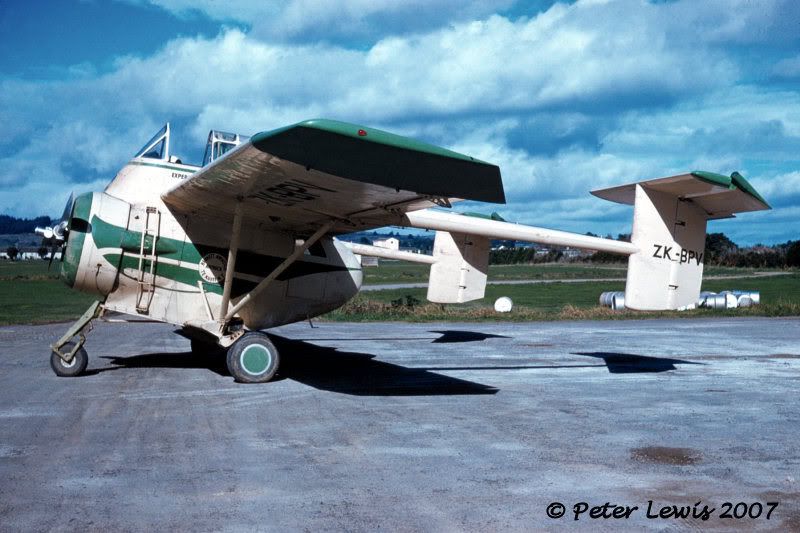 |
|
|
|
Post by fletcherfu24 on Oct 4, 2007 21:42:46 GMT 12
Great photo.The best PL-11 one I've ever seen.
One wonders with all the trouble they went to to make an aircraft out of Harvard bits,why didn't they just do a conversion like the Ceres and just put a hopper in a Harvard?.
|
|
|
|
Post by Kereru on Oct 5, 2007 12:07:51 GMT 12
Nice photo Peter. Do you or anyone else have any pics of the cockpit?
A chap from down country asked me if I had any as he was making a model of it. From memory it was quite a large flying model he was constructing.
Colin
|
|
|
|
Post by Dave Homewood on Oct 5, 2007 13:59:35 GMT 12
That is a great photo, thanks Peter.
|
|
|
|
Post by rotoruian on Oct 8, 2007 13:34:51 GMT 12
Is this the same plane (type) used in the Mel Gibson Mad Max movie?
|
|
|
|
Post by Bruce on Oct 8, 2007 14:53:04 GMT 12
Mad Max had a PL12 Skyfarmer - the later, aussie made derivative. Looks the part really!
|
|
|
|
Post by Peter Lewis on Oct 9, 2007 20:53:52 GMT 12
Do you or anyone else have any pics of the cockpit? Colin Can't help you there Colin, photos of the exterior are rare enough. I would assume a modified Harvard panel? CAA airworthiness branch would have had some internal pics/drawings for sure, during the certification process. He could try there, but they probably have been junked by now. |
|
|
|
Post by fletcherfu24 on Oct 9, 2007 21:13:20 GMT 12
Last year the local paper did a story on John Worthington,he lives in the BOP and the story said he still had the original plans for the PL 11.No doubt a lot of photos also.
|
|
roger
Leading Aircraftman

Posts: 7
|
Post by roger on Oct 20, 2007 21:44:39 GMT 12
The twin booms were more for ease of loading than for safety. the key safety aspect was positioning the cockpit above the hopper and engine, on aircraft such as the Fletcher, the cockpits sits between these two heavy components, and sometimes becomes a crumple zone in frontal crashes. The drawback with the Airtruck (and Airtruk) was the possibility of the whole lot rolling forward end over end. Despite being hideously ugly, there was some merit in the design, which was actually ideal for the job it did. Unfortunately the PL12 did not have the same scope for development that the Fletcher did. The Hopper on the PL12 was an integral structural part of the fuselage, and couldnt be enlarged as engine power increased in the same way the Fletcher could. I have spoken to a number of PL12 pilots who all say that the Airtruk was a great machine to go to work in, and flew really well. The PL11s do have a distinctive "Bitsa" look to them that the later PL12s didnt....... Kinda cool in that quirky, ugly sort of way! As one of the few who actually worked on PL11 #1 (ZK-BPV) I would like to point out that the concept of the twin booms was simply to do away with a rear fuselage. On aircraft such as the Cessna 180/185, FU24, etc., superphosphate in the rear fuselage created major problems with corrosion. Luigi therfore decided to simply do away with a rear fuselage, and hence the twin boom design. I also need to point out that the PL11 was NEVER an attempt to "modify a Harvard for agricultural use". The whole design concept originally grew out of the Australian-built PL7. In response to the initial interest shown by Bennett, Worthington and Gardiner (what became Bennett Aviation) Luigi designed the PL9. But this design never progressed beyond the drawing board. It would have used an ancient Cheta (?) [450 HP radial] engine. When Snow Bennett told Luigi that he had the chance of buying several War-surplus Harvard aircraft with P&W R1340 engines Luigi went back to "square one" and began work on the PL11 -- so called because it was his eleventh aircraft design. We used the engines and associated engine-controls quadrant [throttle, prop and mixture], instruments, instrument panel, fuel cells, main wheels and part of the cockpit canopy. But that was about all that those Harvards contributed to the PL11 Airtruck project. Roger Young |
|
|
|
Post by Dave Homewood on Oct 21, 2007 10:39:08 GMT 12
Interesting stuff Roger. Thanks for your input, and welcome to the forum.
|
|
|
|
Post by Dave Homewood on Oct 30, 2007 11:56:21 GMT 12
Roger (above) phoned me on the weekend from his home in Aussie and has promised to send some photos of the Airtruck for this thread, which I'll add when they arrive. He says he has one not very good one of the interior, the only shot he knows of, but confirmed that from memory they did use the Harvard panel.
|
|
|
|
Post by stingray on Oct 31, 2007 20:18:23 GMT 12
Hi guys, new to the forum. First post to kick things off. Might seem a stupid question bu ti am doing my best to track down any ex RNZAF aircraft that might still be around. These harvards are probably long gone but any information would be appreciated. Also about Rukuhia aircraft. Sorry for the off-topic post but seemed a good place for it. Thanks,
Ryan
|
|
|
|
Post by Peter Lewis on Oct 31, 2007 20:55:38 GMT 12
You need to be a bit more specfic there Stingray.
There's quite a few ex-RNZAF aircraft about - do you mean in private hands, in museums, still flying, under restoration . . . ?
|
|
















